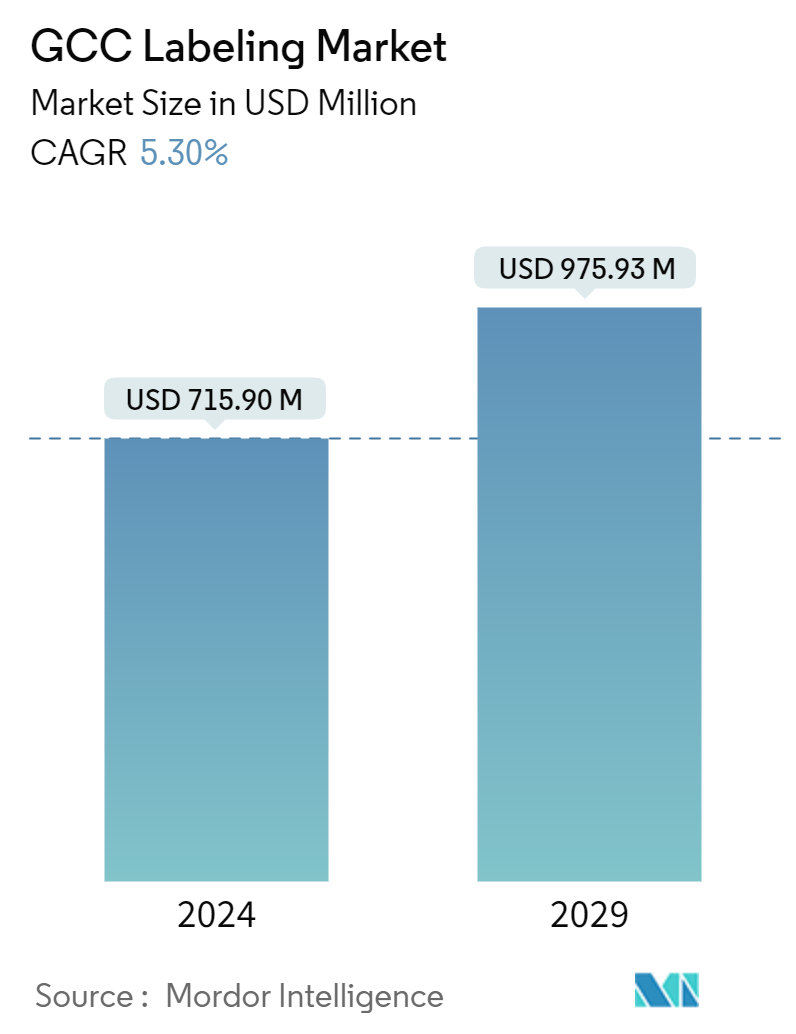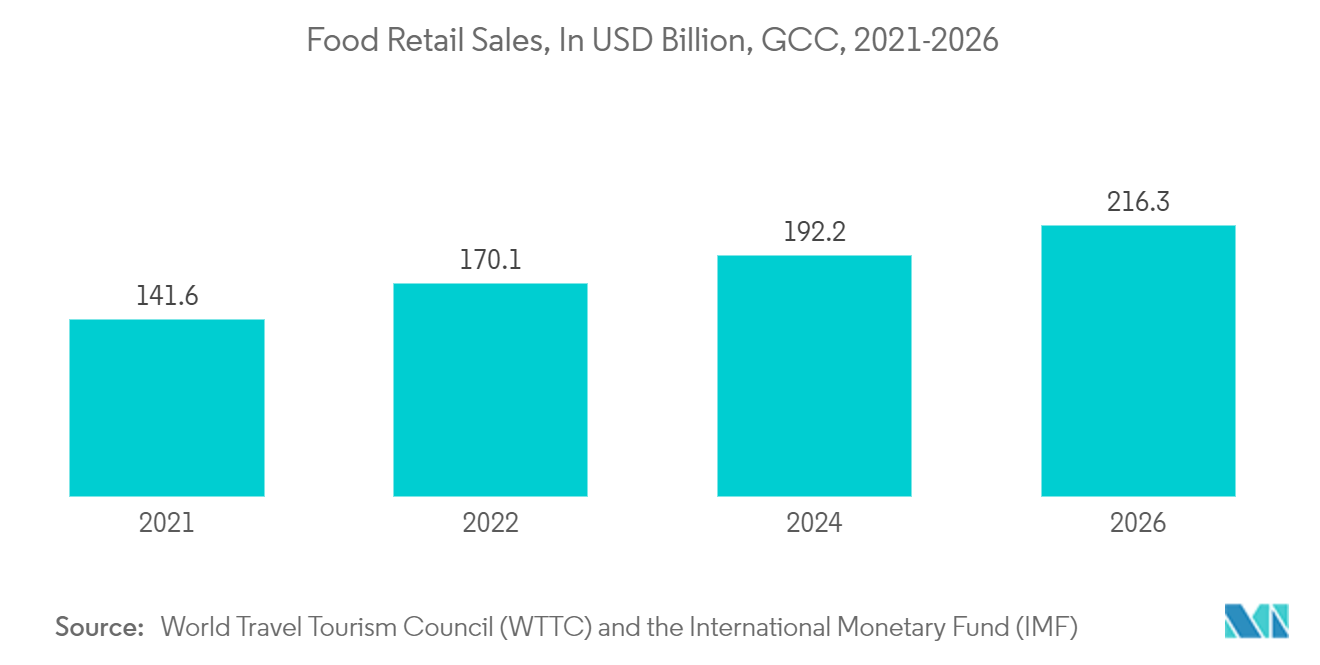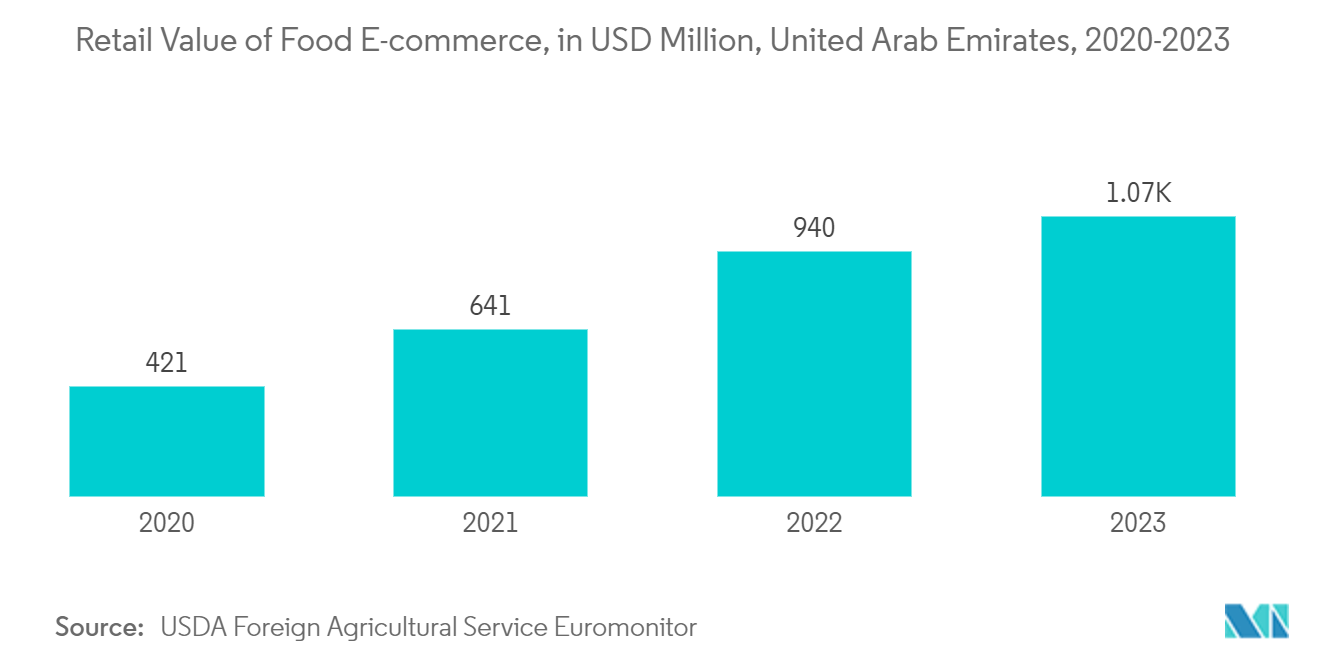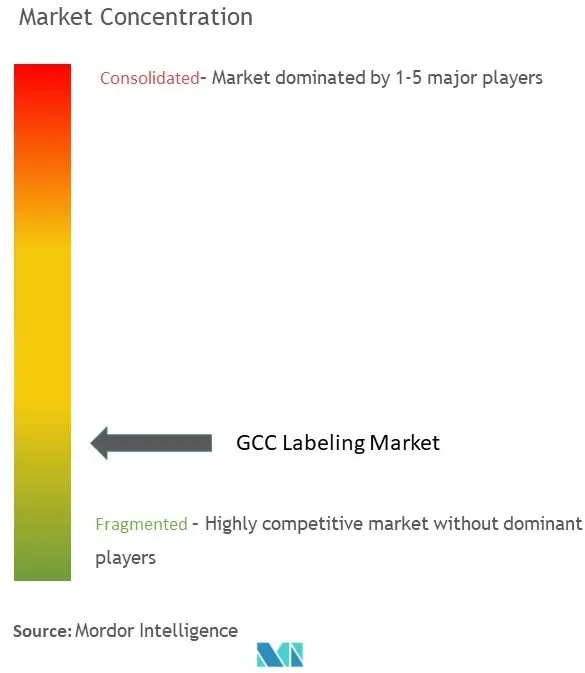GCC Labeling Market Size

| Study Period | 2019 - 2029 |
| Base Year For Estimation | 2023 |
| Market Size (2024) | USD 715.90 Million |
| Market Size (2029) | USD 975.93 Million |
| CAGR (2024 - 2029) | 5.30 % |
| Market Concentration | Low |
Major Players.webp)
*Disclaimer: Major Players sorted in no particular order |
GCC Labeling Market Analysis
The GCC Labeling Market size is estimated at USD 715.90 million in 2024, and is expected to reach USD 975.93 million by 2029, growing at a CAGR of 5.30% during the forecast period (2024-2029).
Technological advancements and the digital shift have strengthened the importance of labeling. As lifestyles evolve, the call for faster, automated labeling solutions intensifies. Driven by a growing appetite for convenient, high-quality food, consumers are turning to packaged options. These choices necessitate clear labeling, including nutritional information and expiry dates, fueling the demand for labels in the region.
GCC countries are diversifying their economies beyond oil and gas, leading to the growth of various industries such as retail, food and beverages, pharmaceuticals, and logistics. These industries require extensive labeling for product identification, branding, and compliance. As of March 2023, data from the National Committee of Dairy Producers in the Federation of Saudi Chambers (FSC) revealed a surge in dairy consumption during Ramadan. Saudi Arabia's milk production peaked at over 7 million liters daily, translating to more than 18 million bottles. The logistics were equally impressive, with over 10,000 trucks ferrying dairy products daily, servicing a network of 38,000 retail outlets. Such expansion in the food industry may further propel the growth of the market studied.
The development of digital printing technology is rapidly penetrating the labeling market due to its cost-effectiveness and high-quality printing on industrial-sized digital presses. Digital technologies, such as digital printing, UV inkjet, and water-based inkjet, are becoming increasingly sophisticated. Additionally, digital printing technology is witnessing demand across all consumer goods industries, including foods, beverages, and pharmaceuticals. The market is driven by continued increases in order volumes, lower supply-side inventory levels, shorter lead times to fulfill order volumes, and lower costs.
The rapid expansion of e-commerce platforms demands efficient and scalable labeling solutions for order fulfillment, inventory management, and logistics. Accurate labeling ensures smooth operations and enhances the customer experience. In addition, a Dubai Chamber of Commerce study revealed that the UAE e-commerce market is expected to be worth USD 9.2 billion in 2026. Growth momentum within the UAE e-commerce industry is supported by growing demand for online shopping and steady investment flows in the industry's infrastructure.
Furthermore, the increasing need for packaged perishable goods is expected to boost label sales in the coming years. The growth of the organized retail industry is a crucial driver for the label market. Retailers rely on labels to track product freshness, with smart labels proving particularly valuable for inventory management. These labels efficiently track inventory, especially as retailers adhere to stock-keeping unit protocols.
The UAE Telecommunications and Digital Government Regulatory Authority (TDRA) introduced a revised label format in January 2023. While all new certificates must feature this new label, businesses can retain the old label or adopt the new one for product renewals. These labels are to be prominently displayed on the packaging of approved products and in retail stores.
The label market encounters challenges due to evolving regulatory requirements, which mandate producers adjust labeling practices regularly. The complexity of the global supply chain makes flexible labeling solutions necessary. Moreover, rising consumer expectations for personalized, visually appealing labels necessitate innovative design approaches, amplifying design difficulties. Given the persistent threat of counterfeiting, stringent security measures are essential.
The Russia-Ukraine War has resulted in economic and supply chain disruptions, which have impacted the packaging industry and, in turn, the labeling market. Moreover, the conflict between Russia and Ukraine caused disruptions in trade dynamics. Furthermore, the war increased oil prices, leading to higher inflation and contracting economies worldwide. According to the Center for Strategic and International Studies, Russia's invasion of Ukraine left few new agricultural markets and threatened people's food security across the Middle East. The war restricted food exports from Ukraine and Russia, impacting the packaging industry. However, the GCC countries, which import up to 90% of their food, have so far weathered the influence of Russia's war with Ukraine.
GCC Labeling Market Trends
The Food Sector Significantly Driving the Market Growth
- The increasing growth of the food industry is significantly propelling the demand for labeling, primarily because governments and regulatory bodies impose strict labeling requirements on the food industry to ensure consumer safety and transparency. Labels must include detailed information about ingredients, nutritional facts, allergens, expiry dates, and country of origin. Compliance with these regulations is essential, driving the need for accurate and comprehensive labeling.
- Some GCC countries have implemented or are considering front-of-pack labeling systems, such as traffic light labeling or Nutri-Score, to provide a quick and easy way for consumers to assess the nutritional quality of food products at a glance. In addition, the GCC Standardization Organization (GSO) works toward harmonizing food labeling regulations across member states to facilitate trade and ensure consistent standards. This includes alignment with international standards set by organizations such as Codex Alimentarius. Such regulations reflect the GCC's commitment to protecting consumer health, promoting transparency, and ensuring that food products meet high safety and quality standards.
- Modern consumers are more health-conscious and demand transparency about the food products they purchase. They seek information on ingredients, nutritional content, sourcing, and potential allergens. Clear and detailed labels help consumers make informed decisions, increasing the demand for effective labeling solutions. According to the World Travel & Tourism Council (WTTC) and the International Monetary Fund (IMF), retail food sales in the nations of the GCC were expected to rise to USD 216.3 billion by 2026.
- Furthermore, the growth of supermarkets, hypermarkets, and specialty food stores increases the variety of consumer products. Each product requires a unique label that meets regulatory standards and provides necessary information. The expansion of retail outlets directly correlates with the increased demand for labeling solutions. For instance, in April 2024, UAE-based grocery store operator Spinneys 1961 Holding PLC announced its plans to debut in Saudi Arabia, capitalizing on the Kingdom’s development and increasing demand for retail products.
- In addition, in August 2023, LuLu Group, a significant retailer in the Middle East, opened its 14th hypermarket in Kuwait. The recent store is located in the Warehouse Mall in South Sabahiya and spans 48,000 square feet. It offers a wide range of products, including fresh produce, groceries, seafood, children’s toys, seasonal party supplies, health and beauty products, electronic and mobile devices and accessories, IT products, peripherals, and premium cosmetics and perfumes under the brand BLSH.
- Also, in a strategic move, the Alshaya Group launched a new production hub in Saudi Arabia, dedicated to baking and packaging food for 400 Starbucks outlets nationwide. With a regional Starbucks portfolio exceeding 1,000 stores, Alshaya Group strengthened the facility's reach and supplied over 500 Starbucks locations in 2023. Such expansion in the food industry may further propel the growth of the market.

The United Arab Emirates to Hold a Significant Market Share
- The United Arab Emirates is significantly driving the market growth. The country's food and beverage industry is expanding rapidly, driven by a growing population, increased tourism, and a rising number of expatriates. This growth necessitates extensive labeling to provide product information, ensure safety, and meet regulatory requirements. According to the World Bank, the number of international tourist arrivals in the United Arab Emirates is expected to constantly expand between 2024 and 2029 by 17.3 million arrivals (+63.32%).
- Furthermore, the country's e-commerce and online grocery shopping surge has amplified the need for accurate and detailed product labeling. In order to ensure consumer trust and satisfaction, online platforms require comprehensive product descriptions and images, including clear labeling information.
- According to the USDA Foreign Agricultural Service, food retail is the fourth largest e-commerce segment in the United Arab Emirates. The retail value of food e-commerce in the United Arab Emirates recorded USD 1,072 million in 2023. In addition, one of the most prominent players in the food e-commerce space in the country was Carrefour UAE, which generated over USD 100 million in revenue in 2023.
- Moreover, the country's expanding healthcare and pharmaceutical industries also contribute to the demand for precise and compliant labeling. Labels in these industries must provide detailed information on dosages, ingredients, usage instructions, and regulatory compliance. For instance, the UAE Ministry of Health and Prevention and Jafza, a DP World company, signed a Memorandum of Understanding (MoU) to develop the healthcare and pharmaceutical industries. This is expected to increase the demand for various products in the region, such as dropper bottles, nasal sprays, and liquid bottles, thereby increasing the demand for pharmaceutical packaging further in labeling.
- Innovations in labeling technologies, such as digital printing, RFID, and QR codes, are enhancing the functionality and efficiency of labels. These technologies support better inventory management, product tracking, and consumer engagement. For instance, in December 2023, Dubai significantly strived toward digital transformation. The city is considering introducing the Dubai Unified License and QR code, marking a pivotal moment in its business landscape. This initiative is poised to revolutionize business operations, spanning from the vibrant mainland to the dynamic free zones of the city.

GCC Labeling Industry Overview
The GCC labeling market is highly fragmented, owing to the presence of various global and local industry players. Vendors in this market participate based on product portfolio, differentiation, and pricing. Major vendors like Mondi Group, CCL Industries, 3M, and Huhtamaki OYJ are the most prominent competitors in the market.
- April 2024 - The Labelexpo Global Series unveiled plans for 'Gulf Print & Pack' in the Kingdom of Saudi Arabia, scheduled for January 21-23, 2025, at the Riyadh Front Exhibition Conference Center (RFECC). This new event, an extension of the successful Dubai-based "Gulf Print & Pack" exhibition, will spotlight advanced commercial and package printing technologies and the region's packaging equipment and materials.
GCC Labeling Market Leaders
-
CCL Industries Inc.
-
Mondi Group
-
3M Company
-
Huhtamaki OYJ
-
Taghleef Industries Inc.
*Disclaimer: Major Players sorted in no particular order

GCC Labeling Market News
- May 2024 - Innovia Films, a significant material science pioneer and a major producer of BOPP films, launched a newly developed, uniquely engineered two-sided coated cavitated film for pressure-sensitive labeling (PSL) applications, which is marketed as Rayoface AQBHA. The polypropylene film offers significant printability with a backside coating specifically designed for hot melt pressure-sensitive label coating.
- March 2024- ReCrysta, a polyethylene terephthalate (PET) film for shrink labels developed by Toyobo Co. Ltd, was recognized as meeting or exceeding the voluntary requirements for the APR Design for recyclability.
- January 2024 - Avery Dennison launched a new decorative linerless technology, AD LinrSave. With this technology, Avery Dennison aims to transform the market for linerless prime labels.
GCC Labeling Market Report - Table of Contents
1. INTRODUCTION
- 1.1 Study Assumptions and Market Definition
- 1.2 Scope of the Study
2. RESEARCH METHODOLOGY
3. EXECUTIVE SUMMARY
4. MARKET INSIGHTS
- 4.1 Market Overview
-
4.2 Industry Attractiveness - Porter's Five Forces Analysis
- 4.2.1 Threat of New Entrants
- 4.2.2 Bargaining Power of Consumers
- 4.2.3 Bargaining Power of Suppliers
- 4.2.4 Threat of Substitute Products
- 4.2.5 Intensity of Competitive Rivalry
- 4.3 Industry Value Chain Analysis
- 4.4 Impact of Key Macroeconomic Trends on the Market
- 4.5 Import And Export Analysis
- 4.6 GCC Labeling - Government Regulations/Requirements
- 4.7 Labeling Equipment Suppliers
5. MARKET DYNAMICS
-
5.1 Market Drivers
- 5.1.1 Growing Demand for Digitally Printed Labels
- 5.1.2 Increased Demand for Labeling in Food and Beverage Industries
-
5.2 Market Restraints
- 5.2.1 Increased Cost of Labeling Machines
6. MARKET SEGMENTATION
-
6.1 By Type
- 6.1.1 Pressure Sensitive Labels
- 6.1.2 Shrink Label
- 6.1.3 In-mold Labels
- 6.1.4 Other Types
-
6.2 By Print Technology
- 6.2.1 Offset Printing
- 6.2.2 Gravure Printing
- 6.2.3 Flexographic Printing
- 6.2.4 Other Printing Technologies
-
6.3 By End-user Industry
- 6.3.1 Food
- 6.3.2 Beverage
- 6.3.3 Healthcare
- 6.3.4 Cosmetics and Personal Care
- 6.3.5 Industrial
-
6.4 By Country
- 6.4.1 United Arab Emirates
- 6.4.2 Saudi Arabia
- 6.4.3 Qatar
- 6.4.4 Rest of GCC
7. COMPETITIVE LANDSCAPE
-
7.1 Company Profiles*
- 7.1.1 CCL Industries Inc.
- 7.1.2 Mondi Group
- 7.1.3 3M Company
- 7.1.4 Huhtamaki OYJ
- 7.1.5 Brady Corporation
- 7.1.6 Taghleef Industries Inc.
- 7.1.7 Sigma Middle East Label Industries LLC
- 7.1.8 Print Pack Labels LLC
- 7.1.9 Honeywell International Inc.
GCC Labeling Industry Segmentation
Labeling encompasses creating and applying labels on a product's outer packaging. They convey vital information and features of the product.
The GCC labeling market is segmented by type (pressure sensitive labels, shrink labels, in-mold labels, and other types), print technology (offset printing, gravure printing, flexographic printing, and other print technologies), end users (food, beverage, healthcare, cosmetics and personal care, industrial), and country (the United Arab Emirates, Saudi Arabia, Qatar, and Rest of GCC). The disturbance of the factors affecting the market's evolution in the near future, as well as drivers and constraints, has been covered in the study. The market sizes and forecasts are provided in terms of value (USD) for all the above segments.
| By Type | Pressure Sensitive Labels |
| Shrink Label | |
| In-mold Labels | |
| Other Types | |
| By Print Technology | Offset Printing |
| Gravure Printing | |
| Flexographic Printing | |
| Other Printing Technologies | |
| By End-user Industry | Food |
| Beverage | |
| Healthcare | |
| Cosmetics and Personal Care | |
| Industrial | |
| By Country | United Arab Emirates |
| Saudi Arabia | |
| Qatar | |
| Rest of GCC |
GCC Labeling Market Research FAQs
How big is the GCC Labeling Market?
The GCC Labeling Market size is expected to reach USD 715.90 million in 2024 and grow at a CAGR of 5.30% to reach USD 975.93 million by 2029.
What is the current GCC Labeling Market size?
In 2024, the GCC Labeling Market size is expected to reach USD 715.90 million.
Who are the key players in GCC Labeling Market?
CCL Industries Inc., Mondi Group, 3M Company, Huhtamaki OYJ and Taghleef Industries Inc. are the major companies operating in the GCC Labeling Market.
What years does this GCC Labeling Market cover, and what was the market size in 2023?
In 2023, the GCC Labeling Market size was estimated at USD 677.96 million. The report covers the GCC Labeling Market historical market size for years: 2019, 2020, 2021, 2022 and 2023. The report also forecasts the GCC Labeling Market size for years: 2024, 2025, 2026, 2027, 2028 and 2029.
GCC Labeling Industry Report
Statistics for the 2024 GCC Labeling market share, size and revenue growth rate, created by Mordor Intelligence™ Industry Reports. GCC Labeling analysis includes a market forecast outlook to for 2024 to 2029 and historical overview. Get a sample of this industry analysis as a free report PDF download.



